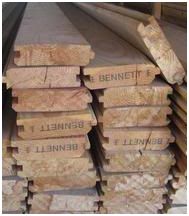My first exposure to tongue and groove lumber was when I managed the prefabricated metal plate connected wood truss manufacturing facility at Lucas Plywood and Lumber back in 1979. I’d relocated from Northern Idaho to Salem, Oregon to take the position.
(Read more about Lucas Plywood and Lumber here: https://www.hansenpolebuildings.com/blog/2011/06/theres-no-education-like-real-life-business-experience/)
The most common method of residential home construction in the Willamette Valley, at the time, was for houses to be constructed over crawl spaces. The subfloor utilized four inch width beams spaced every four feet, with usually 2×8 #3 grade lumber nailed flatwise across the beams. A few of the better builders used 2×8 commercial decking for their subfloors.
To produce commercial decking, a #3 grade board is resawn. The board is passed through a set of what are known as “knives” creating a thin, deep ridged “tongue” on one edge and a slot or “groove” on the other. When properly milled and installed, the tongue fits perfectly within the groove of the preceding member – creating a snug fit. The end product is commonly known as tongue and grooved, or center matched lumber.
Keep in mind, lumber grades are a product of allowable defects (read about allowable defects here: https://www.hansenpolebuildings.com/blog/2013/12/lumber-defects/). One of the most common defects in lumber, which causes downgrading, is wane. The process of center matching lumber is cause for the removal of a large amount of wane, especially if the resaw operator is properly orienting the lumber on the infeed side so the greatest wane is on what will become the tongue edge of the board.
 In pole (post frame) buildings, tongue and groove 2×6 lumber is often used to construct box stalls for horses. What most people do not realize, is the tongue and groove lumber they are ordering to build stalls out of is most often commercial decking – a product of #3 grade material!
In pole (post frame) buildings, tongue and groove 2×6 lumber is often used to construct box stalls for horses. What most people do not realize, is the tongue and groove lumber they are ordering to build stalls out of is most often commercial decking – a product of #3 grade material!
2×6 Select Decking is most often used on top of exposed beams to create aesthetically pleasing ceilings. As it has far fewer defects than #3 grade lumber, it is far more pleasing to the eye, as well as having greater strength properties. (The American Forest & Paper Association has produced this document on Tongue and Groove Roof Decking https://www.awc.org/pdf/wcd2.pdf)
For high quality horse stalls, 2×6 Select Decking is the choice of discerning horse owners and trainers.
P.S. Don’t forget, at a minimum the lower two rows of 2×6 tongue and groove lumber used for stalls should be pressure preservative treated to resist rot and decay from contact with ground, moisture and animal wastes.






